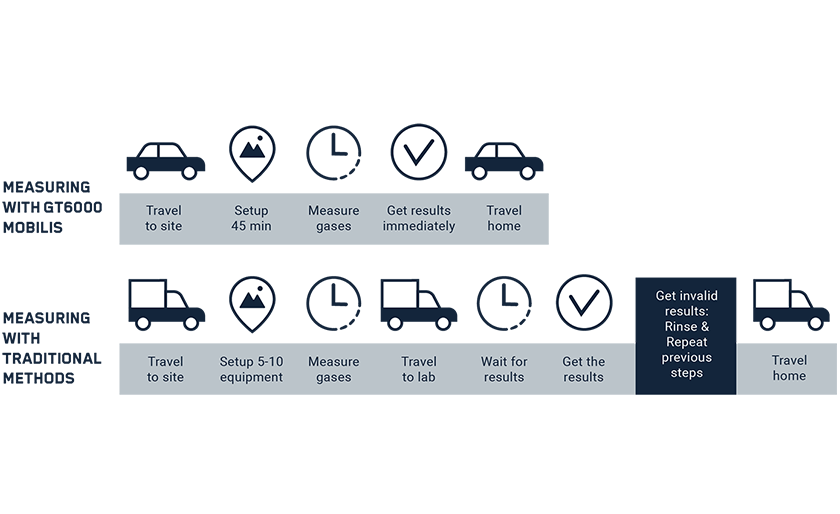
Future of Stack Testing: from manual sampling to continuous on-site measurements
Monitoring emissions is a crucial and straightforward process for every industrial plant, essential for meeting regulatory compliance and safeguarding our environment, thus ensuring everyone’s safety. Beyond the continuous monitoring by the plants, accredited stack testing labs conduct standardized spot checks on the monitoring equipment to prove their performance.
With constantly tightening emission limit values and increased monitoring requirements, new benchmarks for stack testing methods are emerging, prompting a reevaluation of current manual procedures – are they optimized for cost and time efficiency, and do they deliver highly accurate and reliable results.
Consider this: Would you prefer to wait two to three weeks for data that may still carry some uncertainty, or opt for immediate, reliable results available on-site?
What is stack testing?
In general, stack testing refers to periodically performed industrial emission measurements, including quality assurance of continuous emission monitoring systems, regulated periodic measurements as well as non-regulated measurements, e.g. for process improvement purposes. Usually these measurements, guided by standard, are done by a third-party test team of accredited laboratory, called stack testers.
Stack testers offer the measurements as a service for the industrial plants comparing the readings of the CEMS to the ones produced by proven test methods, thus proving the emissions monitoring equipment is performing as it should.
Like any service provider, a stack tester’s goal is also to serve their customer: obtaining excellent quality data and providing more value to the customer with less costs than a competitor, in a shorter time.

The world of stack testing is changing by moving from manual sampling to continuous on-site measurements
Stack testers take the measurement equipment up to the stack, and with traditional instruments they collect the gas specific samples on a few data points manually, meaning a separate measurement method for every gas.
Once collected and prepared for the journey, the samples are first taken down from the stack and then carefully delivered to the laboratory for further analysis. These manual sampling methods are labor-intensive, time-consuming, and non-continuous.
The continuous on-site measurement system, like GT6000 Mobilis, can help optimize processes by bringing lab instrument quality to the field. Its modular design facilitates easy setup: once in a stack, a probe that goes into the stack is connected to a pump which feeds the stack gas straight into analyzer, that transforms the measurement data to a connected laptop.
Dozens of gasses will be measured right there on site, and immediate feedback with a digital readout is provided.
Once set up, the analyzer can keep running and do all the dirty work, so stack testers can use their time to focus on core research. A multi-gas analyzer decreases the number of measurement methods needed, easing the efforts of transporting, setting up and dismantling.
Continuous on-site measurements eliminate the uncertainty on the validity of the measurement results
The portable emission monitoring system can help optimize processes offering instant analysis and delivering real-time results, providing immediate feedback on the progress. Users receive automatic notifications if any unpredictable events occur and any abnormalities in the results or the process can be identified immediately.
There is no need to worry or feel anxious about what the lab report will show. They already know that the collection was successful and have preliminary results, and trips back to site to redo the measurements can be avoided.
With manual sampling methods, the samples are validated only when in the laboratory. In the lab, the samples are analyzed, gas by gas, taking two to three weeks turning the samples into data, and data to results. And still only a few gas-specific data points of the entire spectrum are captured.
Quantify known, identify unknown
What’s more, unlike traditional instruments where you need to know what you are measuring beforehand, the GT6000 Mobilis lets you identify unknown gases. And if something unanticipated is found, unknown gases can be identified within a minute.

An Example of FTIR Measurement Spectrum Illustrated
With multi-gas analysis, utilizing the Fourier Transformed Infrared (FTIR) method, all gases are measured by scanning the same infrared spectrum, the data can be saved and re-analyzed in the future. If there are questions about the data, it can be easily re-checked.
Information about a gas not originally monitored can be extracted from the data you already have, without any extra sample collection.
This is a future-proof and cost-efficient solution for current and future research, as the same analyzer can be used without hardware changes for different measurement needs, with Gasmet’s optimized gas libraries.
Certification – a promise of quality
Being the first and only portable FTIR analyzer with MCERTS EN15267-4 certification, the GT6000 Mobilis sets a new standard for excellence in emission monitoring equipment. Prior to certification, portable FTIR was not widely accepted in EMEA area.
Stack testers can now replace and complement a large variety of methods with one – saving a huge amount of time and money and being able to serve more customers at the same time while improving the result reliability and ensuring accuracy.
The EN15267-4 QAL1-certification for the GT6000 Mobilis further establishes Gasmet as a trusted partner for customers seeking accurate and reliable gas analysis in various applications.
The measurement results are reliable and accurate, i.e., they can be used to monitor that industry’s continuously operating emission measurement devices are working as they should. And that emissions are within the specified limit values crucial for regulatory compliance and for environmental protection.
In a world of increasingly stringent measurement obligations, Gasmet’s accurate measuring devices bring peace of mind to both our customers and ordinary citizens. Streamlined measurement process leaves little room for errors and surprises. In practice, using a portable automatic measuring system when performing compliance measurements will save time, effort, and costs, clearing stack testers schedule fitting more customers to be served in the same timeframe. The whole cycle from planning the measurements to reporting the results is shortened – even by weeks.
